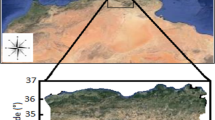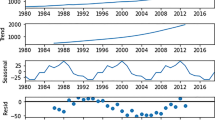Abstract
Due to global energy depletion, solar energy technology has been widely used in the world. The output power of the solar energy systems is affected by solar radiation. Accurate short-term forecasting of solar radiation can ensure the safety of photovoltaic grids and improve the utilization efficiency of the solar energy systems. In the study, a new decomposition-boosting model using artificial intelligence is proposed to realize the solar radiation multi-step prediction. The proposed model includes four parts: signal decomposition (EWT), neural network (NARX), Adaboost and ARIMA. Three real solar radiation datasets from Changde, China were used to validate the efficiency of the proposed model. To verify the robustness of the multi-step prediction model, this experiment compared nine models and made 1, 3, and 5 steps ahead predictions for the time series. It is verified that the proposed model has the best performance among all models.
摘要
由于全球能源枯竭, 太阳能技术已在世界范围内广泛使用, 而太阳能系统的输出功率受太阳辐射影响. 准确的太阳辐射短期预测可以保证光伏电网的安全, 提高太阳能系统的利用效率. 在本研究中, 提出了一种新的利用人工智能的分解促进模型, 以实现太阳辐射多步预测. 所提出的模型包括四个部分: 信号分解(EWT), 神经网络(NARX), 强化学习(Adaboost)和 ARIMA 算法. 基于湖南常德的三个太阳辐射数据集用于检验所提出模型的预测效果. 为了验证多步预测模型的鲁棒性, 本实验对比了 9 个模型, 并对太阳辐射时间序列数据进行了 1、 3 和 5 步的超前预测. 验证了所提模型在所有模型中具有最佳的预测性能.
Similar content being viewed by others
References
GUERMOUI M, MELGANI F, DANILO C. Multi-step ahead forecasting of daily global and direct solar radiation: A review and case study of Ghardaia region [J]. Journal of Cleaner Production, 2018, 201: 716–734. DOI: https://doi.org/10.1016/j.jclepro.2018.08.006.
FATEMI S A, KUH A, FRIPP M. Parametric methods for probabilistic forecasting of solar irradiance [J]. Renewable Energy, 2018, 129: 666–676. DOI: https://doi.org/10.1016/j.renene.2018.06.022.
DAVID M, LUIS M A, LAURET P. Comparison of intraday probabilistic forecasting of solar irradiance using only endogenous data [J]. International Journal of Forecasting, 2018, 34(3): 529–547. DOI: https://doi.org/10.1016/j.ijforecast.2018.02.003.
MOHANTY S, PATRA P K, MOHANTY A, VISWAVANDYA M, RAY P K. Artificial intelligence based forecasting & optimization of solar cell model [J]. Optik, 2019, 181: 842–852. DOI: https://doi.org/10.1016/j.ijleo.2018.12.176.
ZHENG Wei-qin, PENG Xian-gang, LU Di, ZHANG Dan, LIU Yi, LIN Zhe-hao, LIN Li-xiang. Composite quantile regression extreme learning machine with feature selection for short-term wind speed forecasting: A new approach [J]. Energy Conversion and Management, 2017, 151: 737–752. DOI: https://doi.org/10.1016/j.enconman.2017.09.029.
KUSHWAHA V, PINDORIYA N M. A SARIMA-RVFL hybrid model assisted by wavelet decomposition for very short-term solar PV power generation forecast [J]. Renewable Energy, 2019, 140: 124–139. DOI: https://doi.org/10.1016/j.renene.2019.03.020.
BAKKER K, WHAN K, KNAP W, SCHMEITS M. Comparison of statistical post-processing methods for probabilistic NWP forecasts of solar radiation [J]. Solar Energy, 2019, 191: 138–150. DOI: https://doi.org/10.1016/j.solener.2019.08.044.
AGUIAR L M, PEREIRA B, LAURET P, DÍAZ F, DAVID M. Combining solar irradiance measurements, satellite-derived data and a numerical weather prediction model to improve intra-day solar forecasting [J]. Renewable Energy, 2016, 97: 599–610. DOI: https://doi.org/10.1016/j.renene.2016.06.018.
CERVONE G, CLEMENTE-HARDING L, ALESSANDRINI S, DELLE MONACHE L. Short-term photovoltaic power forecasting using artificial neural networks and an analog ensemble [J]. Renewable Energy, 2017, 108: 274–286. DOI: https://doi.org/10.1016/j.renene.2017.02.052.
INAGE S I. Development of an advection model for solar forecasting based on ground data first report: Development and verification of a fundamental model [J]. Solar Energy, 2017, 153: 414–434.
SUN Yu-chi, VENUGOPAL V, BRANDT A R. Short-term solar power forecast with deep learning: Exploring optimal input and output configuration [J]. Solar Energy, 2019, 188: 730–741. DOI: https://doi.org/10.1016/j.solener.2017.05.019.
YAGLI G M, YANG D Z, SRINIVASAN D. Automatic hourly solar forecasting using machine learning models [J]. Renewable and Sustainable Energy Reviews, 2019, 105: 487–498. DOI: https://doi.org/10.1016/j.rser.2019.02.006.
LAN Hai, ZHANG Chi, HONG Ying-yi, HE Yin, WEN Shu-li. Day-ahead spatiotemporal solar irradiation forecasting using frequency-based hybrid principal component analysis and neural network [J]. Applied Energy, 2019, 247: 389–402. DOI: https://doi.org/10.1016/j.apenergy.2019.04.056.
INAGE S I. Development of an advection model for solar forecasting based on ground data. Part II: Verification of the forecasting model over a wide geographical area [J]. Solar Energy, 2019, 180: 257–276. DOI: https://doi.org/10.1016/j.solener.2018.12.068.
AYET A, TANDEO P. Nowcasting solar irradiance using an analog method and geostationary satellite images [J]. Solar Energy, 2018, 164: 301–315. DOI: https://doi.org/10.1016/j.solener.2018.02.068
KAMADINATA J O, KEN T L, SUWA T. Sky image-based solar irradiance prediction methodologies using artificial neural networks [J]. Renewable Energy, 2019, 134: 837–845. DOI: https://doi.org/10.1016/j.renene.2018.11.056
JANG H S, BAE K Y, PARK H S, SUNG D K. Solar power prediction based on satellite images and support vector machine [J]. IEEE Transactions on Sustainable Energy, 2016, 7(3): 1255–1263. DOI: https://doi.org/10.1109/TSTE.2016.2535466.
YADAV A K, CHANDEL S S. Solar radiation prediction using artificial neural network techniques: A review [J]. Renewable and Sustainable Energy Reviews, 2014, 33: 772–781. DOI: https://doi.org/10.1016/j.rser.2013.08.055.
CITAKOGLU H. Comparison of artificial intelligence techniques via empirical equations for prediction of solar radiation [J]. Computers and Electronics in Agriculture, 2015, 118: 28–37. DOI: https://doi.org/10.1016/j.compag.2015.08.020.
SHARIFI S S, REZAVERDINEJAD V, NOURANI V. Estimation of daily global solar radiation using wavelet regression, ANN, GEP and empirical models: A comparative study of selected temperature-based approaches [J]. Journal of Atmospheric and Solar-Terrestrial Physics, 2016, 149: 131–145. DOI: https://doi.org/10.1016/j.jastp.2016.10.008.
ZHANG Y, BEAUDIN M, TAHERI R, ZAREIPOUR H, WOOD D. Day-ahead power output forecasting for small-scale solar photovoltaic electricity generators [J]. IEEE Transactions on Smart Grid, 2015, 6(5): 2253–2262. DOI: https://doi.org/10.1109/TSG.2015.2397003.
ASRARI A, WU T X, RAMOS B. A hybrid algorithm for short-term solar power prediction: Sunshine state case study [J]. IEEE Transactions on Sustainable Energy, 2017, 8(2): 582–591. DOI: https://doi.org/10.1109/TSTE.2016.2613962.
QUEJ V H, ALMOROX J, ARNALDO J A, SAITO L. ANFIS, SVM and ANN soft-computing techniques to estimate daily global solar radiation in a warm sub-humid environment [J]. Journal of Atmospheric and Solar-Terrestrial Physics, 2017, 155: 62–70. DOI: https://doi.org/10.1016/j.jastp.2017.02.002.
BASER F, DEMIRHAN H. A fuzzy regression with support vector machine approach to the estimation of horizontal global solar radiation [J]. Energy, 2017, 123: 229–240. DOI: https://doi.org/10.1016/j.energy.2017.02.008.
ZOU Ling, WANG Lun-che, XIA Li, LIN Ai-wen, HU Bo, ZHU Hong-ji. Prediction and comparison of solar radiation using improved empirical models and adaptive neuro-fuzzy inference systems [J]. Renewable Energy, 2017, 106: 343–353. DOI: https://doi.org/10.1016/j.renene.2017.01.042
OZOEGWU C G. Artificial neural network forecast of monthly mean daily global solar radiation of selected locations based on time series and month number [J]. Journal of Cleaner Production, 2019, 216: 1–13. DOI: https://doi.org/10.1016/j.jclepro.2019.01.096.
LIU Hui, JIN Kai-rong, DUAN Zhu. Air PM2,5 concentration multi-step forecasting using a new hybrid modeling method: Comparing cases for four cities in China [J]. Atmospheric Pollution Research, 2019, 10(5): 1588–1600. DOI: https://doi.org/10.1016/j.apr.2019.05.007.
SHANG Chuan-fu, WEI Peng-cheng. Enhanced support vector regression based forecast engine to predict solar power output [J]. Renewable Energy, 2018, 127: 269–283. DOI: https://doi.org/10.1016/j.renene.2018.04.067.
MAJUMDER I, DASH P K, BISOI R. Variational mode decomposition based low rank robust kernel extreme learning machine for solar irradiation forecasting [J]. Energy Conversion and Management, 2018, 171: 787–806. DOI: https://doi.org/10.1016/j.enconman.2018.06.021.
MONJOLY S, ANDRÉ M, CALIF R, SOUBDHAN T. Hourly forecasting of global solar radiation based on multiscale decomposition methods: A hybrid approach [J]. Energy, 2017, 119: 288–298. DOI: https://doi.org/10.1016/j.energy.2016.11.061.
WANG Z, TIAN C, ZHU Q, HUANG M. Hourly solar radiation forecasting using a Volterra-least squares support vector machine model combined with signal decomposition [J]. Energies, 2018, 11(1): 68. DOI: https://doi.org/10.3390/en11010068.
ESEYE A T, ZHANG Jian-hua, ZHENG De-hua. Short-term photovoltaic solar power forecasting using a hybrid wavelet-PSO-SVM model based on SCADA and meteorological information [J]. Renewable Energy, 2018, 118: 357–367. DOI: https://doi.org/10.1016/j.renene.2017.11.011.
BENMOUIZA K, CHEKNANE A. Small-scale solar radiation forecasting using ARMA and nonlinear autoregressive neural network models [J]. Theoretical and Applied Climatology, 2016, 124(3, 4): 945–958. DOI: https://doi.org/10.1007/s00704-015-1469-z.
SUN Shao-long, WANG Shou-yang, ZHANG Guo-wei, ZHENG Jia-li. A decomposition-clustering-ensemble learning approach for solar radiation forecasting [J]. Solar Energy, 2018, 163: 189–199. DOI: https://doi.org/10.1016/j.solener.2018.02.006.
YANG Da-zhi. On post-processing day-ahead NWP forecasts using Kalman filtering [J]. Solar Energy, 2019, 182: 179–181. DOI: https://doi.org/10.1016/j.solener.2019.02.044.
FENG C, CUI M J, HODGE B M, ZHANG J. A data-driven multi-model methodology with deep feature selection for short-term wind forecasting [J]. Applied Energy, 2017, 190: 1245–1257. DOI: https://doi.org/10.1016/j.apenergy.2017.01.043.
ALFADDA A, RAHMAN S, PIPATTANASOMPORN M. Solar irradiance forecast using aerosols measurements: A data driven approach [J]. Solar Energy, 2018, 170: 924–939. DOI: https://doi.org/10.1016/j.solener.2018.05.089.
LIU Hui, MI Xi-wei, LI Yan-fei. Wind speed forecasting method based on deep learning strategy using empirical wavelet transform, long short term memory neural network and Elman neural network [J]. Energy Conversion and Management, 2018, 156: 498–514. DOI: https://doi.org/10.1016/j.enconman.2017.11.053.
BENALI L, NOTTON G, FOUILLOY A, VOYANT C, DIZENE R. Solar radiation forecasting using artificial neural network and random forest methods: Application to normal beam, horizontal diffuse and global components [J]. Renewable Energy, 2019, 132: 871–884. DOI: https://doi.org/10.1016/j.renene.2018.08.044.
EL MGHOUCHI Y, CHHAM E, ZEMMOURI E M, EL BOUARDI A. Assessment of different combinations of meteorological parameters for predicting daily global solar radiation using artificial neural networks [J]. Building and Environment, 2019, 149: 607–622. DOI: https://doi.org/10.1016/j.buildenv.2018.12.055.
SALISU S, MUSTAFA M W, MUSTAPHA M, MOHAMMED O O. Solar radiation forecasting in Nigeria based on hybrid PSO-ANFIS and WT-ANFIS approach [J]. International Journal of Electrical and Computer Engineering (IJECE), 2019, 9(5): 3916. DOI: https://doi.org/10.11591/ijece.v9i5.pp3916-3926.
GILLES J. Empirical wavelet transform [J]. IEEE Transactions on Signal Processing, 2013, 61(16): 3999–4010. DOI: https://doi.org/10.1109/TSP.2013.2265222.
MARCJASZ G, UNIEJEWSKI B, WERON R. On the importance of the long-term seasonal component in day-ahead electricity price forecasting with NARX neural networks [J]. International Journal of Forecasting, 2019, 35(4): 1520–1532. DOI: https://doi.org/10.1016/j.ijforecast.2017.11.009.
JAMIL M, ZEESHAN M. A comparative analysis of ANN and chaotic approach-based wind speed prediction in India [J]. Neural Computing and Applications, 2019, 31(10): 6807–6819. DOI: https://doi.org/10.1007/s00521-018-3513-2.
WANG Yu, WANG Chun-heng, SHI Cun-zhao, XIAO Bai-hua. Short-term cloud coverage prediction using the ARIMA time series model [J]. Remote Sensing Letters, 2018, 9(3): 274–283. DOI: https://doi.org/10.1080/2150704X.2017.1418992.
ZHANG G P. Time series forecasting using a hybrid ARIMA and neural network model [J]. Neurocomputing, 2003, 50: 159–175. DOI: https://doi.org/10.1016/S0925-2312(01)00702-0.
FREUND Y, SCHAPIRE R E. A decision-theoretic generalization of on-line learning and an application to boosting [J]. Journal of Computer and System Sciences, 1997, 55(1): 119–139. DOI: https://doi.org/10.1006/jcss.1997.1504.
XING H J, LIU W T. Robust AdaBoost based ensemble of one-class support vector machines[J]. Information Fusion, 2020, 55: 45–58. DOI: https://doi.org/10.1016/j.inffus.2019.08.002.
LI Lin, HUANG Yi-xiang, TAO Jian-feng, LIU Cheng-liang, LI Kai. Featured temporal segmentation method and AdaBoost-BP detector for internal leakage evaluation of a hydraulic cylinder [J]. Measurement, 2018, 130: 279–289. DOI: https://doi.org/10.1016/j.measurement.2018.08.029.
Author information
Authors and Affiliations
Contributions
HUANG Jia-hao performed writing original draft, review, editing and experimental validation. LIU Hui performed proposing forecasting ideas, writing original draft and, review and experimental validation.
Corresponding author
Ethics declarations
The authors declare that they have no known competing financial interests or personal relationships that could have appeared to influence the work reported in this paper.
Additional information
Foundation item: Project(2020TJ-Q06) supported by Hunan Provincial Science & Technology Talent Support, China; Project(KQ1707017) supported by the Changsha Science & Technology, China; Project(2019CX005) supported by the Innovation Driven Project of the Central South University, China
Rights and permissions
About this article
Cite this article
Huang, Jh., Liu, H. A hybrid decomposition-boosting model for short-term multi-step solar radiation forecasting with NARX neural network. J. Cent. South Univ. 28, 507–526 (2021). https://doi.org/10.1007/s11771-021-4618-9
Received:
Accepted:
Published:
Issue Date:
DOI: https://doi.org/10.1007/s11771-021-4618-9




